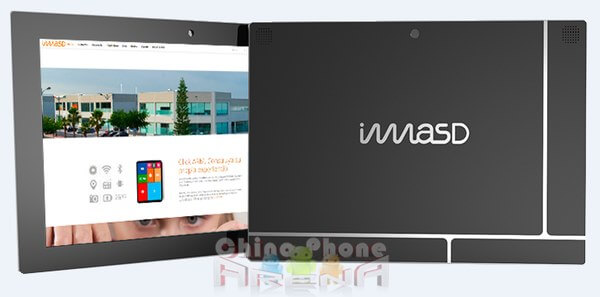We recently wrote a preview of Google’s Project Ara, but Google isn’t the only one looking towards modular tablets and phones.
ImasD Technologies has recently introduced the Click ARM One, a modular tablet which uses the CKHUB101 motherboard and coming our way sometime in Q3 of 2015 at $313 USD.
Sometime in 2015, consumers will be able to purchase a modular tablet or phone.
The ARM portion of the model’s name has no relation to the CPU technology licensing company ARM Holdings, it’s an acronym for “Advanced Removable Modules” and allows you to swap parts out as they become obsolete or malfunction.
It’s a genius idea that surprisingly never came to fruition with laptops and notebooks. Perhaps because the technology just wasn’t there yet, or perhaps to keep you buying the next generation notebooks. Whatever the case, the technology is literally right around the corner. Sometime in 2015, consumers will be able to purchase a modular tablet or phone.
ImasD Technologies, housed in Spain, is amazingly only comprised of 10 people — six hardware engineers and four software engineers. Also worth of note is that ImasD has financed the project through their own revenue.
 The first prototype produced by ImasD was made in 2012 using the well known Allwinner brand SoC and have spent the last couple of years ironing out issues such as differential signals, compatibility, connectivity, modular integrity and platform choices. All of this inhouse development has cost ImasD approximately $2 million euros.
The first prototype produced by ImasD was made in 2012 using the well known Allwinner brand SoC and have spent the last couple of years ironing out issues such as differential signals, compatibility, connectivity, modular integrity and platform choices. All of this inhouse development has cost ImasD approximately $2 million euros.
At this point, the company has produced five motherboards ranging from 2.8″-7″.
The director of ImasD, Pedro Peláez, explained that their platform will develop components as thin as 4.5mm and will be based on modules and core modules. In the works so far are standalone GPS, tablets and mobile phones. At this point, the company has produced five motherboards ranging from 2.8″-7″.
At this point, scheduled for SoC modules, are Cortex M3-based options, Exynos 4, Exynos 5, Exynos A7, IMX6 and Intel Baytrail solutions.
The modules interact through standard protocols such as USB, SPI, GPIO, I2C and UART I/O.
The earlier mentioned Click ARM One comes stock with Exynos 4412 w/2GB RAM. A 16GB storage module and an I/O hub that offers WiFi, Bluetooth, HDMI and 2 USB ports will be available as modular components. Currently the only display option planned is a 10.1″ 1280×800 Samsung LCD. In the future, a PCIe slot module will be available as well. More options will become available throughout 2015.
The modules interact through standard protocols such as USB, SPI, GPIO, I2C and UART I/O. Each socket the modules connect to have their own digital identifiers for software recognition purposes. Each module has an EPROM with the data required to interact with the mainboard. Also on the plate is that independent developers will be able to create their own modules, which will be certified by ImasD.
After choosing the appropriate software, the OS will be compiled automatically and available within five hours.
The OS will be based on Linux and as with modular hardware, ImasD partners will be able to make their own OS by combining various software chunks available on the Click ARM website. After choosing the appropriate software, the OS will be compiled automatically and available within five hours.
The auto-compiler will have more than one OS available depending on the modules you use. Among the OS planned so far are Android, Sailfish, Ubuntu and possibly Tizen.
Not only tablets are being planned by ImasD. Also in the works is a modular phone aptly dubbed “PuzzlePhone”. According to ImasD, PuzzlePhone modules will be compatible with Click ARM One and vice versa.
One of the biggest hurdles for all modular companies is to get customers to see the value of the modular system.
While ImasD is tiny in comparison to Google, Google doesn’t even have a pilot program yet, while Click ARM One is already on the market and will be available retail within the next couple of months. Already 20,000 sales have been made to B2B (Business-to-Business as opposed to Business-to-Consumer). At this point ImasD sees themselves as a sort of OEM technology platform licensor, but may do B2C marketing as well.
One of the biggest hurdles for all modular companies is to get customers to see the value of the modular system. Most users are fairly happy with their closed-system devices, and indeed if you were to purchase a modern mobile it should not be obsoleted for at least two years, which for many is about the amount of time an everyday electronic device begins to fail physically and begins to look a bit outdated stylistically. The other issue is price. $313 is a big chunk of dough and $100-200 budget tablets are rapidly becoming more powerful and cheaper.
There certainly is a coolness factor here that can’t be denied, and tech geeks around the world will likely jump on a chance to own one just for the sheer awesomeness of it, but in terms of the general public it may be a steep uphill battle.
The Click ARM modular tablet is available for $313 USD direct from ImasD. The PuzzlePhone will be available before Q1 2016.

Leave a Reply